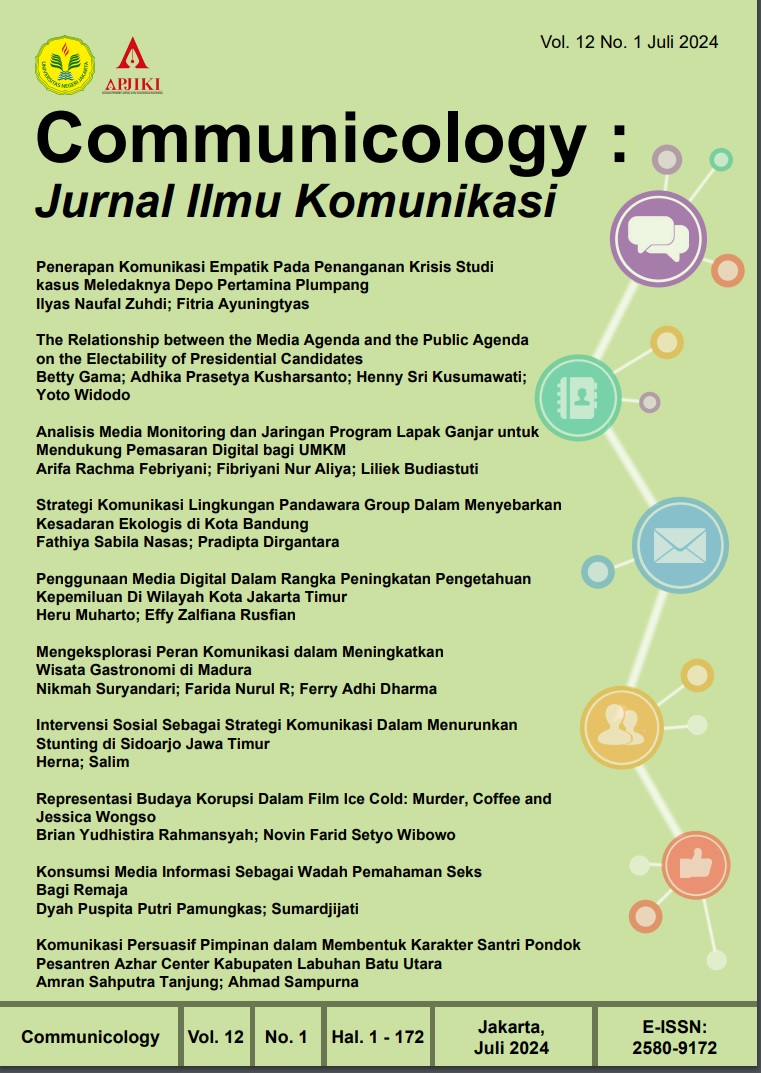Analisis Media Monitoring dan Jaringan Program Lapak Ganjar untuk Mendukung Pemasaran Digital bagi UMKM
DOI:
https://doi.org/10.21009/COMM.032.03Keywords:
Digital Marketing, E-WOM, Lapak Ganjar, NetlyticAbstract
Lapak Ganjar is a program launched by the Governor of Central Java Ganjar Pranowo since July 2020 to help promote commodities for Central Java MSMEs, especially when facing economic challenges during the ongoing Covid-19 pandemic, via Instagram @lapak_ganjar. This program is developing to support digital marketing for MSMEs, not only MSMEs in Central Java, but also MSMEs in several other provinces. This research aims to describe the analysis of media monitoring and network of the Lapak Ganjar program to support digital marketing for MSMEs. Several relevant concepts are used in this research, including the concepts of digital marketing and electronic word of mouth (e-WOM). This type of research is quantitative descriptive with media monitoring and network analysis methods using brand24 and netlytic. Media monitoring analysis was carried out in the period June to July 2022. The results of media monitoring analysis via brand24 in that period revealed that the Lapak Ganjar program received positive sentiment from netizens, while Twitter analysis using Netlytic in June to July 2022 found a total of 2,013 tweets mentioning the word Lapak Ganjar with some relevant related keywords. Network analysis via Netlytic also displays cluster 1 which refers to the account most frequently referred to, namely the ganjaranapps account.
References
Ansyari, S. (2021, July 26). Sudah 53 Ribu UMKM di Jateng Terdampak Pandemi. Viva.Co.Id. https://www.viva.co.id/berita/nasional/1390372-sudah-53-ribu-umkm-di-jateng-terdampak-pandemi?page=all
Azer, J., & Ranaweera, C. (2022). Former customers’ E-WOM in social media platforms: An investigation of motives, network size and social ties. Journal of Business Research, 146, 118–133. https://doi.org/10.1016/j.jbusres.2022.03.068
Belhadi, A., Kamble, S., Benkhati, I., Gupta, S., & Mangla, S. K. (2023). Does strategic management of digital technologies influence electronic word-of-mouth (eWOM) and customer loyalty? Empirical insights from B2B platform economy. Journal of Business Research, 156. https://doi.org/10.1016/j.jbusres.2022.113548
Dwi, Y., & Ariyanti, P. (2022). Analisis Centrality Aktor pada Penyebaran Informasi Kuliner di Media Sosial dengan menggunakan Social Network Analysis. Journal of Systems, Information Technology, and Electronics Engineering, 2(1), 23–31. http://e-journal.ivet.ac.id/index.php/jsitee
Ekasari, R. (2023). NETNOGRAPHIC STUDIES ON ELECTRONIC WORD OF MOUTH AS A DIGITAL MARKETING COMMUNICATION STRATEGY IN KOTA TUA JAKARTA. Jurnal Administrasi Bisnis, 3(2), 236–242. http://ojs.stiami.ac.id/index.php/JAMBIS
Febriyani, A. R., & Budiastuti, L. (2022). PRODUCTION OF TESTIMONIAL VIDEOS TO SUPPORT THE IMPLEMENTATION OF THE LAPAK GANJAR PROGRAM. Proceeding 2nd International Conference on Communication Science (ICCS 2022), 562–567. https://doi.org/https://doi.org/10.29303/iccsproceeding.v2i1
Fiona, F., Susetyo, S., Nasution, & Putri, A. M. P. (2022). Digital Marketing Through Social Media Instagram as a Promotion Means to Increase Interest in Visiting Bengkulu Tourism Objects. Proceedings of the 7th Sriwijaya Economics, Accounting, and Business Conference (SEABC 2021).
Hutagalung, S. S., Kartika, T., & Suciska, W. (2023). Media Monitoring Analysis of Government Image in Infrastructure Development in Indonesia. Jurnal Komunikasi, 15(1), 212–227. https://doi.org/10.24912/jk.v15i1.20605
Karin, C., & Abner, R. P. (2022). Strategy for Using Instagram as a Digital Marketing Communication Media to Increase MSME Product Sales. Budapest International Research and Critics Institute-Journal (BIRCI-Journal), 5(2). https://doi.org/10.33258/birci.v5i2.5245
Mustajab, R. (2023, January 31). Indonesia Miliki 97,17 Juta Pengguna Instagram hingga Akhir 2022. DataIndonesia.Id. https://dataindonesia.id/internet/detail/indonesia-miliki-9717-juta-pengguna-instagram-hingga-akhir-2022
Nurul Khaerani, S. (2022). THE USE OF DIGITAL MARKETING AND ITS IMPACT ON INCREASING MSME SALES. Interdisciplinary Social Studies , 1(8), 1054–1061.
Rachmawati, F., Rahmawati, D. H., & Wibowo, A. A. (2022). Ikoy Ikoy Digital Marketing Public Relations Strategy on Instagram. Advances in Social Science, Education and Humanities Research, 672, 3.
Shalihah, N. F., & Wedhaswary, I. D. (2021, November 19). UMKM Bisa Promosi Gratis di #LapakGanjar, Begini Caranya. Kompas.Com. https://www.kompas.com/tren/read/2021/11/19/192000465/umkm-bisa-promosi-gratis-di-lapakganjar-begini-caranya?page=all
Wibisono, E. (2023). Discovering Key Actors and Opinion Leaders on Twitter’s Start-Up and Entrepreneurship Topics Trending: A Social Network Analysis Approach Menemukan Aktor Utama dan Opini Pemimpin pada Topik Start-Up dan Kewirausahaan yang Sedang Tren: Pendekatan Analisis Jaringan Sosial. Jurnal Ilmu Pengetahuan Dan Teknologi Komunikasi, 25(1), 37–56. https://doi.org/10.17933/iptekkom.25.1.2023.37-56
Widiastuti, C. T., Puspitasari, W., Irene, ) ;, & Setiawan, N. (2022). DAMPAK PANDEMI COVID-19 PADA UMKM DI KOTA SEMARANG (Studi Pada UMKM Tempe di Kelurahan Sendangguwo Semarang). Jurnal Ilmiah Bidang Ilmu Ekonomi, 20(3), 236–242.
Downloads
Published
How to Cite
Issue
Section
License
Authors who publish with this Journal agree to the following terms:
- Author retain copyright and grant the journal right of first publication with the work simultaneously licensed under a creative commons attribution licensethat allow others to share the work within an acknowledgement of the work’s authorship and initial publication of this journal.
- Authors are able to enter into separate, additional contractual arrangementfor the non-exclusive distribution of the journal’s published version of the work (e.g. acknowledgement of its initial publication in this journal).
- Authors are permitted and encouraged to post their work online(e.g. in institutional repositories or on their websites) prior to and during the submission process, as it can lead to productive exchanges, as well as earlier and greater citation of published works.
Users/public use of this website will be licensed to CC BY





